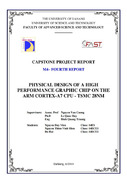
Please use this identifier to cite or link to this item:
http://thuvienso.dut.udn.vn/handle/DUT/5518| DC Field | Value | Language |
|---|---|---|
| dc.contributor.advisor | PGS. TS Nguyễn, Văn Cường | en_US |
| dc.contributor.advisor | TS. Lê Quốc Huy | en_US |
| dc.contributor.advisor | Đinh, Quang Trường | en_US |
| dc.contributor.author | Nguyễn, Duy Viên | en_US |
| dc.contributor.author | Nguyễn, Thiên Vinh Hiển | en_US |
| dc.contributor.author | Đỗ, Hải | en_US |
| dc.date.accessioned | 2025-02-15T08:54:02Z | - |
| dc.date.available | 2025-02-15T08:54:02Z | - |
| dc.date.issued | 2019 | - |
| dc.identifier.uri | http://thuvienso.dut.udn.vn/handle/DUT/5518 | - |
| dc.description | 108 Tr. | en_US |
| dc.description.abstract | In the era of accelerated-growing technology, Application-Specific Integrated Circuit (ASIC), which is a kind of integrated circuit that is specially built for a specific application or purpose, can be found in almost any electronic device and its uses can range from custom rendering of images to sound conversion. Because of the requirement of enhancing the speed and reducing power as well as cost, the emergence and development of ASIC is crucial and essential. Produce an ASIC successfully requests a mature process of many correlated and complex steps, in which, Physical Design is one of them. Physical Design, which is a step of the standard design cycle which follows after the Circuit Design, transforms a circuit description into the physical layout which describes the position of cells and routes for the nterconnections between them. This step is usually split into several sub-steps, which include design, verification and validation of the layout. Physical Design is based on gate-level netlist generated from the Synthesis Process and uses the technology libraries that are provided by the fabrication houses. Technologies are commonly classified according to minimal feature size, i.e. 90nm, 65nm, 45nm, 28nm, 22nm, 18nm, 14nm, etc. In this project, we are going to design a layout for ARM Cortex-A7 CPU, which is a 32-bit microprocessor core licensed by ARM holdings implementing the ARMv7- A architecture. By optimizing Physical Design steps, we are aiming to reduce data transmission time inside the ARM module, hence, the layout can meet the frequency of 800 MHz, considered as a high-speed chip. Besides, TSMC 28nm technology is used in this project because it features high erformance and low power consumption advantages plus seamless integration with its 28nm design ecosystem to enable faster time-to-market. The 28nm process technology supports a wide range of applications and highly prefer by customer. | en_US |
| dc.language.iso | en | en_US |
| dc.publisher | Trường Đại học Bách khoa - Đại học Đà Nẵng | en_US |
| dc.subject | Graphic chip | en_US |
| dc.subject | Cortex-a7 cpu | en_US |
| dc.title | Physical design of a high performance graphic chip on the arm cortex-a7 cpu - TSMC 28nm | en_US |
| dc.type | Đồ án | en_US |
| dc.identifier.id | 2.DA.FA.19.013 | - |
| item.openairecristype | http://purl.org/coar/resource_type/c_18cf | - |
| item.openairetype | Đồ án | - |
| item.cerifentitytype | Publications | - |
| item.fulltext | Có toàn văn | - |
| item.languageiso639-1 | en | - |
| item.grantfulltext | restricted | - |
| Appears in Collections: | DA.Hệ thống nhúng | |
Files in This Item:
| File | Description | Size | Format | Existing users please Login |
|---|---|---|---|---|
| 2.DA.FA.19.013.Nguyen Duy Vien.pdf | Thuyết minh | 22.27 MB | Adobe PDF |  |
CORE Recommender
Items in DSpace are protected by copyright, with all rights reserved, unless otherwise indicated.